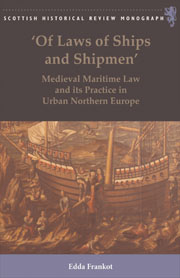Book contents
- Frontmatter
- Contents
- Tables and Maps
- Abbreviations
- Acknowledgements
- Preface
- Introduction
- 1 A History of Maritime Law in Northern Europe
- 2 Shipwreck, Jettison and Ship Collision in Maritime Law
- 3 The Five Towns Introduced
- 4 Written Law: Urban Collections of Sea Law
- 5 Written Law: Local Developments in Lawmaking
- 6 Legal Practice: the Administration of Maritime Justice
- 7 Legal Practice: Maritime Proceedings at the Urban Courts
- Final Conclusions
- Bibliography
- Index
6 - Legal Practice: the Administration of Maritime Justice
Published online by Cambridge University Press: 05 August 2013
- Frontmatter
- Contents
- Tables and Maps
- Abbreviations
- Acknowledgements
- Preface
- Introduction
- 1 A History of Maritime Law in Northern Europe
- 2 Shipwreck, Jettison and Ship Collision in Maritime Law
- 3 The Five Towns Introduced
- 4 Written Law: Urban Collections of Sea Law
- 5 Written Law: Local Developments in Lawmaking
- 6 Legal Practice: the Administration of Maritime Justice
- 7 Legal Practice: Maritime Proceedings at the Urban Courts
- Final Conclusions
- Bibliography
- Index
Summary
The administration of maritime justice in general was conducted on two levels. Although this study focuses mainly on the practice of maritime law in the town courts, justice was also administered on board ships. As there is almost no information about this practice, as it was oral in nature, only a few comments can be made on it here. In Article 85 of the Lübeck Town Law (‘Van tuge in schepes richte’; see Table 4.2) it is laid down that, when a complaint was brought before the skipper and others on board ships, and judgement was passed by the shipmaster, the case did not need to be taken to another court. This article was included in the Town Law between 1263 and 1275. None of the other written laws refers to the jurisdiction of the skipper. Although the Lübeck article does not specify which cases could be taken before this ship's court, the shipmaster's jurisdiction would have been restricted to matters in which he himself was not involved. Most of these cases would have concerned discipline on board. That groups of skippers requested additional regulation concerning this subject repeatedly in a Hanseatic context throughout the fourteenth and fifteenth centuries, resulting in the Ordnung für Schiffer und Schiffsleute and the 1482 Schifferordnung, indicates that they administered justice in these cases themselves. It also suggests that shipmasters required assistance from the law to maintain discipline on their ships and could not stipulate rules themselves. Town courts, on the other hand, could formulate laws if none were available in writing.
- Type
- Chapter
- Information
- Of Laws of Ships and ShipmenMedieval Maritime Law and its Practice in Urban Northern Europe, pp. 144 - 165Publisher: Edinburgh University PressPrint publication year: 2012



